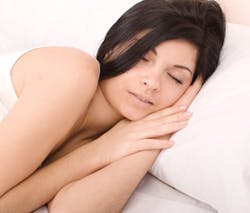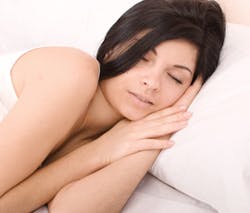Catch some ZZZs
Knock out sleep apnea
By Heidi Emmerling Muñoz, PhD
I was shocked when I was told that I had severe sleep apnea. Although I have always snored and woken up tired, I sleep a lot. However, according to my sleep study report, I experienced 402 sleep apnea episodes (where I was not taking in enough oxygen or when I stopped breathing) in my seven-and-a-half-hour sleep cycle. What this meant was that for almost every minute of sleep, I was hypoxic -- not breathing. It is no wonder that every morning, for as long as I could remember, I woke up tired and just wanted to go back to sleep. Other symptoms that led to my doctor ordering this sleep study included fatigue, headaches, anxiety, difficulty concentrating, and depression. But these symptoms all seemed so normal to me, as they do to many others. According to Abad and Guilleminault, one of every 15 adults has moderate sleep apnea with 3 to 5% of the population being undiagnosed.1 Sleep apnea is more than just not sleeping well. It can lead to high blood pressure, congestive heart failure, pulmonary hypertension, heart disease, strokes, or death.2
There is more than one type of sleep apnea. In the dental field we frequently discuss obstructive sleep apnea, in which the upper respiratory airway is physically blocked during sleep. With obstructive sleep apnea, there is no problem of brain regulation of breathing. Rather, a deviated septum, congestion, enlarged tonsils, weak pharyngeal muscles, or facial or vocal cord injury could cause the blockage. Other risk factors related to obstructive sleep apnea include obesity, which narrows the air passage; medications or alcohol leading to excessive airway muscle relaxation; neuromuscular diseases such as stroke; upper respiratory infections; and smoking.
--------------------------------------------------------------------------
Consider reading these articles
- Sleep apnea considerations for the restorative patient
- Hidden dental dangers of undiagnosed obstructive sleep apnea
- Using oral and dental devices to treat snoring and sleep apnea
--------------------------------------------------------------------------
The other type of sleep apnea that we hear less frequently about is central sleep apnea. In this case, there is an abnormal regulatory mechanism in the brain preventing it from telling the lungs to take a breath during sleep. The brain's recognition or response to oxygen and carbon dioxide levels is impaired. Some causes include congenital abnormalities or premature birth, heart failure, certain medications, strokes, or even high altitude. Central sleep apnea can also be primary, which means it is not associated with an underlying cause.2
Physicians generally diagnose sleep apnea beginning with an interview of the patient and the discussion of symptoms. The physician evaluates the medications as well as social habits such as smoking and alcohol consumption. Next, the physician will do a complete physical evaluation to include heart, lungs, weight, neck circumference, oral cavity, pharynx, tonsils, and nasal passages. Additionally, the physician may discuss snoring with the patient's family or partner. If other diagnoses are not ruled out, the physician may order a polysomnography (PSG) test. These are performed through an overnight stay at a sleep lab. An alternative, and what they did in my case, was oximetry, a machine that had the ability to read and record my respiratory indices, oxygen saturation, and REM statistics -- all done with a finger monitor strapped to the machine while I slept.
Sleep apnea can be treated in a number of ways. For obstructive sleep apnea, some dentists will fabricate a mandibular advancement device (MAD) that effectively repositions the jaw, moving the lower jaw forward and preventing the tongue from falling back during sleep. These appliances are also termed mandibular repositioning devices (MRD) or jaw retainers. Trade names include Thornton Adjustable Positioner, Herbst appliance, Tomed Somnoguard, Somni Snore Guard, Hilsen Oral Appliance, Silent Sleep Device, The Silencer Device, OrthoApnea Appliance, VitalSleep Mouthpiece, and others.3 This treatment can work for milder cases of obstructive sleep apnea but does not work for cases of central sleep apnea. It can also cause myofascial pain, excessive salivation, and changes in occlusion.
Surgery has been used for more severe cases of sleep apnea when oral devices or machines have proven ineffective. The surgery involves removal of the soft tissues causing the obstruction: soft palate, uvula, tongue reduction, tonsils, and so forth. Again, this will not work for central sleep apnea and the risks and possible permanent side effects posed from surgery make this a final option rather than a first or second option. Additionally, because the oropharyngeal anatomy is completely restructured, there is immense recovery time and aftereffects can include changes in appearance and vocal intonations.
Medical devices such as CPAP (continuous passive airway pressure) machines are the cornerstone treatment for obstructive or central sleep apnea. They involve a nose mask connected to a machine via a long hose (so the patient can toss and turn). The nasal mask stays attached to the patient's head through adjustable straps. The machine pushes air into the airway and the patient can customize the air pressure. For central sleep apnea, the physician may prescribe a BiPAP or noninvasive positive pressure ventilation device instead of a CPAP. The difference is the CPAP delivers one level of constant pressure while the BiPAP/noninvasive positive pressure device has two levels of airway pressure: high, when the patient inhales, and low, when the patient exhales (making exhalation easier).4 There are drawbacks, since the devices are unattractive and bulky and patients might not wear the device all night or every night. Additionally, the airflow can be drying to the skin and airway. Nasal pillows can be used for smaller profiles. However, these still have to be strapped to the head and have to be changed more frequently than the masks. Some BiPAP machines have humidifiers to address the dryness. The BiPAP machines are also costly.
Diet, weight, and exercise are important in addressing sleep apnea. Patients should avoid eating or exercising immediately prior to sleep and avoid foods that can exacerbate acid reflux or otherwise interrupt sleep (chocolate, soda, fried foods, alcohol, caffeine, high-fat meat, and dairy products). Instead, opt for foods that soothe acid reflux and calm the GI track, such as oatmeal, ginger, salads (minus the onions, tomatoes, and acidic or fatty dressings), bananas, melon, fennel, roots and greens, celery, parsley, couscous, and rice.5 Maintaining the ideal body weight can decrease some instances of obstructive sleep apnea by having less flesh to obstruct the airway and increasing the width of the airway. Since smoking severely impairs the respiratory system, smoking cessation should be a priority when addressing sleep apnea.
Also, to decrease insomnia, try to have a regular sleep routine by retiring and rising at the same time every day, including weekends and vacations. Make sure there is no television in the bedroom and that your bedroom is only for sleep and intimacy. Consider having a bedtime routine that triggers your body that it is time to go to sleep; consider a warm bath, a few minutes of reading or listening to music, and laying out your morning dishes for breakfast and your clothes for the next day.
Make sure your room is conducive to good sleep by having it dark, quiet, and at a comfortable temperature. If necessary, invest in a good mattress, sheets, some window shades, a bedside fan, or a white noise machine. Also, consider your sleep position. More apnea episodes happen when supine. Possibly something as simple as lateral sleep positioning can decrease episodes of sleep apnea.
My diagnosis of severe primary central sleep apnea came as a surprise and it was a large missing piece to the puzzle of my overall health issues. I am grateful for my 100% medical coverage with no copay for sleep apnea. I confess that I do not wear my BiPAP every night and occasionally if I wake in the middle of the night I take it off and do not put it back on. I dislike -- no, I despise -- the appearance of the device and the feel of the straps. The humidifier in my machine helps some with the dryness. The benefits keep me wearing it somewhat regularly. I used to feel suffocated at night, but I no longer feel that way. When I am awake I indeed feel refreshed. I also have fewer symptoms of sleep apnea -- my headaches, anxiety and panic attacks, difficulty with focus, and depression have all decreased. My 40-pound weight loss has also helped with my sleep apnea, as well as my overall health. I have a way to go with my health journey, including more pounds to lose and more to add to my fitness routine. My regular bedtime routine helps me wind down the day so when my head hits my 600-thread count cotton sheets surrounding my fluffy pillows and warm blankets, I am less bothered by the hoses and mask of my machine and look forward to a restful and regenerative sleep -- and to being more energized and productive the next day.
Heidi Emmerling Muñoz, PhD, is a professor of English at Cosumnes River College. Prior to her current position, Dr. Muñoz was interim director and professor of dental hygiene at Sacramento City College. She has written numerous articles and columns and is a frequent contributor to RDH. Dr. Muñoz can be reached at [email protected].
References
1. Abad VC, Guilleminault C. Neurological perspective on obstructive and nonobstructive sleep apnea. Semin Neurol 2004;24(3):261-9.
2. Sleep Apnea. Emedicine. Emedicine. N.d.
3. Mandibular Advancement Device. Sleep Apnea Guide. Sleep Apnea. N.d.
4. Sleep apnea devices. Apria Healthcare. Apria. N.d.
5. Heartburn and diet. Health.com. Health.com. N.d.
Past RDH Issues

